Samsung UE46ES6800 Review
Samsung UE46ES6800
The UE46ES6800 shows that quality pictures aren’t restricted to Samsung’s flagship TVs.
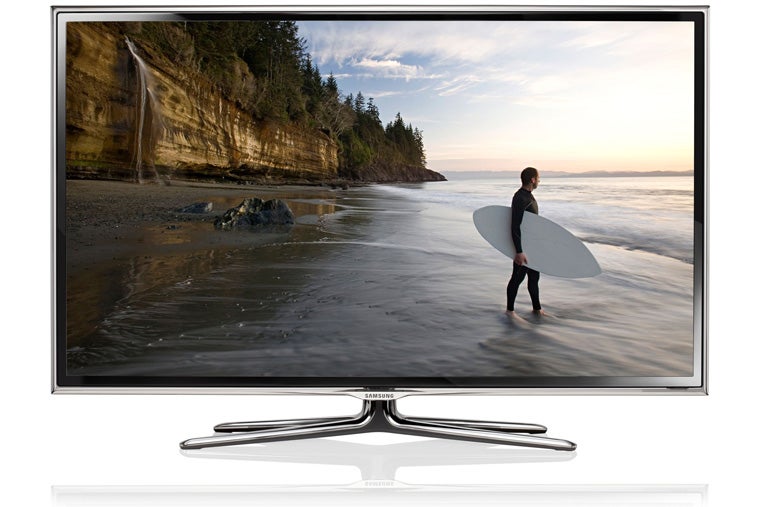
Verdict
Pros
- Cutely designed
- Mostly very good picture quality
- Excellent online service
Cons
- Backlight inconsistencies, especially with 3D
- Very unhelpful picture presets
- Crosstalk with 3D
Key Specifications
- Review Price: £1114.00
- 46in LCD with edge LED lighting
- active 3D playback
- Samsung Smart TV online service
- ‘400Hz’ processing
- Two pairs of 3D glasses included
Samsung always likes to kick off each new TV season by rolling out its big guns; its biggest flagship models, complete with all the designer looks and cutting edge features the Korean brand can muster. But while these sets might be great for establishing Samsung’s brand image, when it comes to cold, hard sales it’s usually the models a couple of steps down Samsung’s range that the majority of punters want to get their hands on. Models like, in other words, the Samsung UE46ES6800 we’re looking at today.
This 46in model belongs two steps below the previous tested ES8000 models, and as such makes its charms available for a cool £500 less than the UE46ES8000. This clearly makes the UE46ES6800 a more mass market proposition. But it also inevitably raises questions of just how many features might have been sacrificed to make such a price drop possible.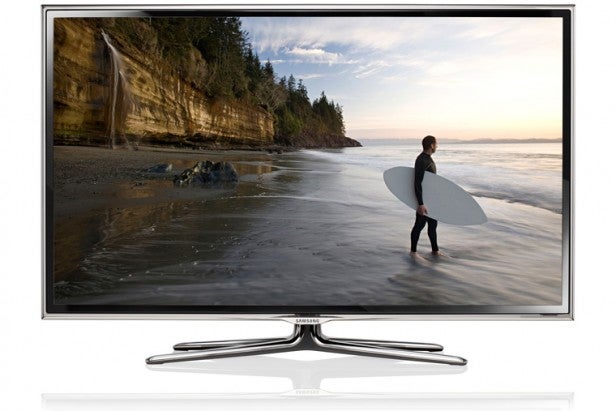
The first difference hits you as soon as you take the UE46ES6800 out of the box. For in place of the ‘barely there’ silver bezel of the ES8000 sets, you get a wider black bezel, offset by 3-4mm of transparent outer trim. The UE46ES6800 also uses a cross-shaped stand design instead of the eye-catching ‘arch’ of the ES8000s. While this all means that the UE46ES6800‘s design isn’t as ‘sci-fi’ as that of the ES8000s, though, it’s still very attractive.
Connections
Connections are more or less as strong as those of the ES8000 series though, and include three HDMIs, three USBs, a D-Sub PC port, both satellite and terrestrial RF inputs, and both LAN and built-in Wi-Fi options for accessing either DLNA PCs or Samsung’s Smart TV online service via your broadband router.
The HDMIs are all v1.4 in spec to cope with full HD 3D inputs, while the USBs can be used for playing back a wide array of video, music and photo file formats, or for recording to USB HDD from the set’s tuners. The satellite tuner is quite unusual in that it actually supports the Freesat HD platform.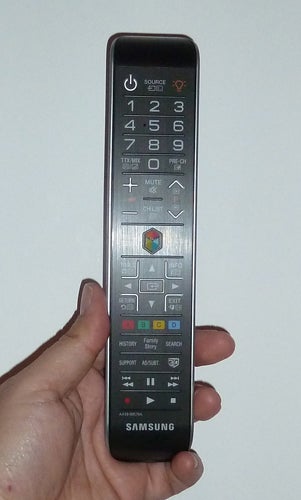
The Samsung UE46ES6800’s online features appear to be the same as those of the UE46ES8000 (more on these later), though one key difference finds the UE46ES6800 lacking the built-in camera found on the ES8000s. This means you’ll have to add an optional external camera if you want to use Skype or some of the set’s Family Zone features via your TV.
No Gesture Control
The lack of a camera also means that the UE46ES6800 doesn’t offer the groundbreaking gesture control functionality sported by Samsung’s higher-end models. Some will find this no big deal given that we haven’t wholly seen eye to eye with this gesture control system so far. But not being able to control your TV by hand movements does mean that unlike the ES8000s, you can no longer operate the Samsung UE46ES6800 without needing a physical handset.
The UE46ES6800 also ships without the second, touchpad remote control found with the ES8000 models, and furthermore can’t be controlled via your voice unlike the ES8000 models. Basically, with the UE46ES6800 you get a revamped but still fairly typical remote control and that’s it.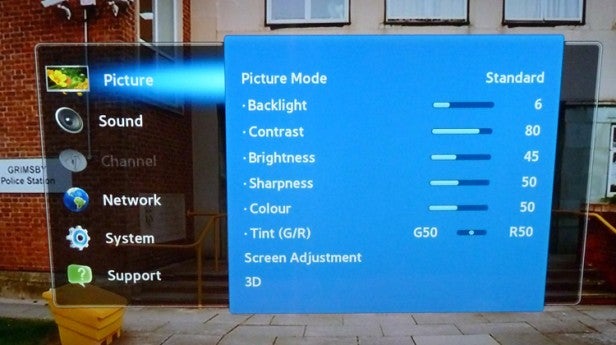
More differences between the UE46ES6800 and Samsung’s flagship TVs materialise as you delve through their feature lists. For starters, unlike the ES8000s, the UE46ES6800 doesn’t use one of Samsung’s top-line Ultra Clear Panel designs. It also offers a Clear Motion Rate of 400Hz versus the 800Hz of the ES8000s, meaning we’ll need to be on the look out for potential motion flaws.
Micro Dimming
Next, while the Samsung UE46ES6800 does enjoy a level of micro dimming when automatically calculating the best picture settings to use at any given moment, the amount of picture areas assessed by the dimming processing isn’t as high and therefore accurate as it is with the ES8000 series.
Wrapping up the important differences, the UE46ES6800 can’t be upgraded with a ‘Smart Evolution’ pack like the ES8000s can, and lacks the 3D audio system of its flagship sibling. The cheaper model does, though, also have a couple of smallish advantages of its own, namely slightly reduced power consumption, and the ability to swivel around on its stand.
Looking at the Samsung UE46ES6800’s other features, its picture set up options provide some good controls over the various processing systems the TV carries – including the key MotionPlus motion enhancement engine – as well as enthusiast-friendly touches such as gamma controls and white balance adjustments. There’s no endorsement, though, from the Imaging Science Foundation (ISF), and typically for Samsung, the provided picture presets are very unhelpful.
The 3D skinny
The Samsung UE46ES6800’s 3D abilities are, of course, active in nature; you get the feeling that Samsung would rather shut its TV business down than ever employ a passive system like the one developed by its arch rival LG. We were pleased to find that Samsung includes two pairs of active 3D glasses for free with the UE46ES6800 – the same number you get with the ES8000 series, and two more than you get free with most Panasonic 3D TVs this year. 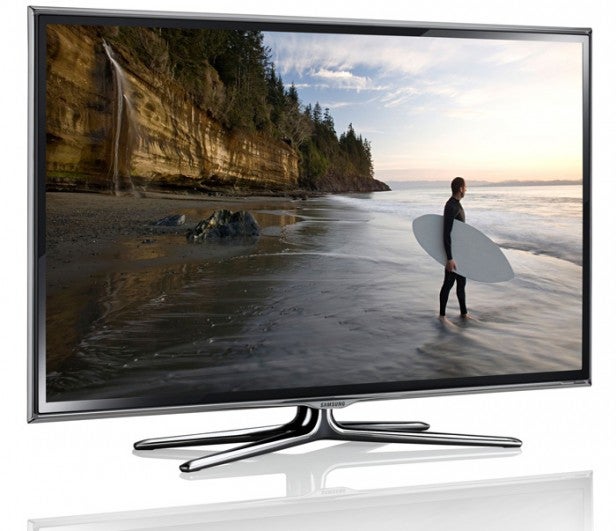
Hitting the multi-coloured ‘Smart Hub’ button on the UE46ES6800’s remote calls up the same entirely gorgeous home screen witnessed on Samsung’s flagship TVs. This sensibly gives you easy access to both the TV’s online and DLNA/USB picture sources as well as the usual tuner and AV input TV stalwarts.
Dominating the centre of the Smart Hub are the same three new online feature ‘zones’ noted on Samsung’s 8 series models this year – one devoted to Fitness, one devoted to setting up a closed network of family members and friends for sharing photos and messages across TVs, PCs or tablets, and one aimed at entertaining the kids. We won’t go into detail on all these again as we’ve covered them before, such as in the review of the Samsung UE55ES8000. But while all three sections could certainly be improved, mostly by adding more content, they’re also all important first steps in changing the way we relate to our TVs.
Video Apps agogo
The Samsung UE46ES6800 also sports a strong selection of video source apps, including Samsung’s own 3D ‘channel’, Netflix and YouTube. There’s no sign of previous Samsung Smart TV stalwarts the BBC iPlayer or LoveFilm at the time of writing, but Samsung assures us that these are just going through significant updates and will be available again by the end of May.
Samsung provides dozens and dozens of small-scale gaming and information apps, though as we’ve noted before, most of these aren’t worth the screen space they take up, frankly.
Despite not having as high spec a panel or as much image processing as the ES8000 series, the UE46ES6800 is still an extremely accomplished performer with HD sources. The combination of punchy colours, fairly extreme contrast and excellent clarity and sharpness that define so many Samsung TVs, especially when watching bright, colour-rich content, is abundantly apparent, and appears initially at least to give the lie to the fact that the UE46ES6800 costs £500 less than its 8000 series equivalent.
It’s not a high-end TV because…
If you look really closely during bright scenes there’s a little less subtlety in the picture’s rendition of very bright picture areas, and skin tones look a touch less life-like. But these are just the differences between a truly high-end HD picture and one that’s still enormously satisfying for a 46in TV costing only a shade over £1100.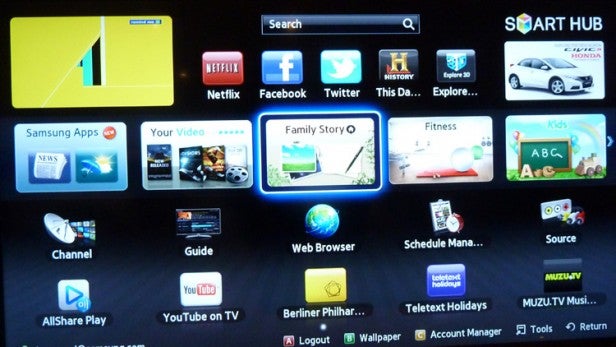
With any Samsung TV, dark scenes need to be given especially careful scrutiny, to see if there are any backlight clouding problems caused by the edge LED lighting system. The usual situation is that areas of light ‘clouding’ is quite obvious if you stick with any of the provided picture presets, but that this problem can usually be removed by reducing the backlight to its six or seven setting, and knocking the contrast back to between 75 and 80.
Stubborn jets
However, unfortunately even these tried and tested measures don’t totally eradicate the clouding problems on the UE46ES6800. In particular there are two stubborn jets of light shooting into the picture from two points either side of the centre of the bottom edge on our review sample that were still marginally visible during dark scenes even with the backlight set down to six.
On the upside, the set’s general black level response is impressive for such an affordable screen, and it’s achieved without taking as much shadow detail out of the picture as you might expect (so long as you avoid the Natural preset, which turns dark areas of the picture into empty black holes).
It’s worth stressing, too, that the backlight clouding is only really visible with extremely dark scenes when watched in a dark room; you don’t see any problems at other times if you have the backlight under control.
One last point to cover about the Samsung UE46ES6800’s HD pictures is their motion handling. This is solid, with minimal judder if you use the provided motion processing tools – tools that can deliver their smoothing tricks without making the image look processed provided you stick with the Clear setting.
There is evidence of resolution loss over moving objects, though, even with the Motion Plus system in action. Careful tinkering with the judder and blur reduction options can yield benefits, allowing you to combat the resolution loss without making the picture look unnatural and over-processed. But motion certainly doesn’t seem quite as convincing as it does on either Samsung’s 8000 series or the recently reviewed Sony 46HX853.
3D under the microscope
Turning to 3D, the UE46ES6800 is a mixed bag. On the one hand, Samsung’s uncanny knack for retaining more brightness and colour richness than most active sets despite the inevitable dimming effect of active 3D glasses remains intact. There’s bags of detail in its 3D images too, with no sense of any line structure or sharpness loss that you get with passive 3D technology. Flickering didn’t trouble us either, at least when viewing in a reasonably darkened room.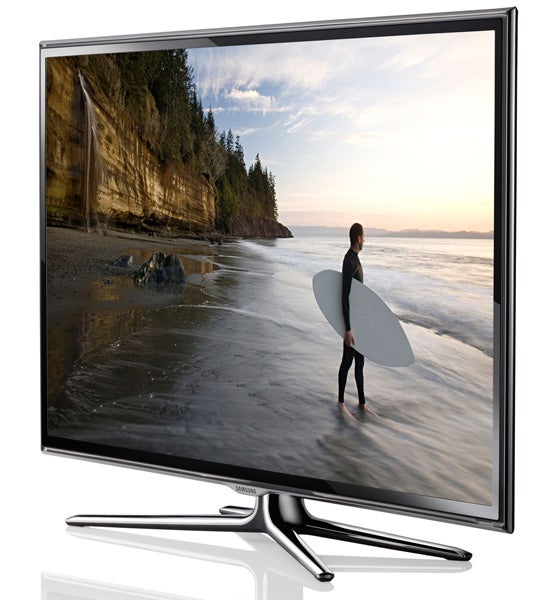
There are two problems with 3D, though. First, the backlight inconsistencies noted earlier are more marked during 3D viewing, partly because the panel has to be driven brighter, and partly because the appearance of these ‘2D’ clouding areas over a 3D image makes them stand out more.
Crosstalk
The other 3D issue is crosstalk. Samsung’s 8000 sets have almost got rid of crosstalk this year, but we frequently spotted it on the UE46ES6800 – especially, though not exclusively, where bright objects appear against dark backgrounds. It’s nothing like as bad as the crosstalk horror show witnessed on, say, last year’s 7 series models from Sony. But it can distract at times, as well as reducing the sense of sharpness in the image.
The final picture point to consider on the UE46ES6800 is standard definition. And happily the set makes a pretty good fist of it, adding extra detail without emphasising noise, over-stressing edges or losing colour accuracy. Standard definition pictures look a bit softer than they do on Samsung’s flagship sets, perhaps, but not to a really annoying degree.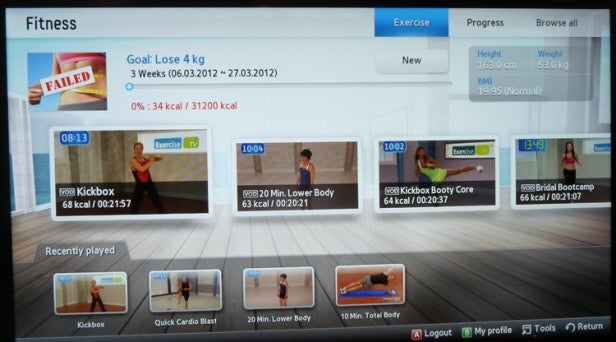
Sonically the UE46ES6800 is one of Samsung’s better efforts. The volume the set can hit before things start to distort are good, the soundstage is propelled a decent distance from the TV’s surround, and there’s even a fair dynamic range, with a spot of (albeit slightly boxy) bass at one end and some lively treble handling at the other.
Samsung has long been keen to associate itself with games consoles in its marketing, so it’s just as well that our final measurement for this test, input lag, came in at only around 34ms – low enough not to dent your gaming skills in any serious way. Please note, though, that to get this level of input lag you need to hunt down the TV’s Game mode, bizarrely tucked away in the General submenu of the TV’s System menu.
Verdict
The Samsung 46ES68000 is a very credible mid-range LED TV, especially once you take its affordable price into consideration. It’s not, though, a perfect one, especially if you’re interested in its 3D capabilities.
How we test televisions
We test every TV we review thoroughly over an extended period of time. We use industry standard tests to compare features properly. We’ll always tell you what we find. We never, ever, accept money to review a product.
Trusted Score
Score in detail
-
Features 9
-
3D Quality 7
-
Value 8
-
Design 9
-
2D Quality 8
-
Sound Quality 8
Features
| Size (Inch) | 46in |
| Display Type | LED |
| Max. Resolution | 1920 x 1080 |
| Full HD 1080p | Yes |
| Digital Tuner | Yes |
| Freeview HD | Yes |
| Freesat HD | No |
| 3D Ready | Yes |
| Refresh Rate (Hertz) | 400 (CMR)Hz |
Connectivity
| HDMI | 3 (v1.4) |
| Component | 1 |
| Composite | 1 |
| Scart | 1 (RGB) |
| Digital Audio Out | Yes (optical) |
| Headphone | 1 |
| Charging/Computer Connection | 3 |
| Ethernet | Yes |
| WiFi | Yes (built-in) |
Physical Specifications
| Height (Millimeter) | 635.6mm |
| Width (Millimeter) | 1070.2mm |
| Depth (Millimeter) | 46.9mm |
| Weight (Gram) | 1360g |

